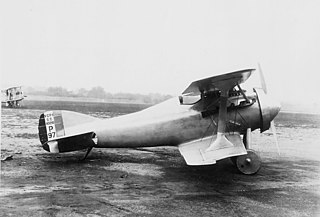
The Douglas Y1B-7 was a 1930s American bomber aircraft. It was the first US monoplane given the B- 'bomber' designation. The monoplane was more practical and less expensive than the biplane, and the United States Army Air Corps chose to experiment with monoplanes for this reason. At the time the XB-7 was ordered, it was being tested by Douglas Aircraft as an observational plane.

The Bell XFL Airabonita was an experimental carrier-based interceptor aircraft developed for the United States Navy by Bell Aircraft Corporation of Buffalo, New York. It was similar to and a parallel development of the U.S. Army Air Corps’ land-based P-39 Airacobra, differing mainly in the use of a tailwheel undercarriage in place of the P-39's tricycle gear. Only one prototype was built.

The Curtiss P-60 was a 1940s American single-engine single-seat, low-wing monoplane fighter aircraft developed by the Curtiss-Wright company as a successor to their P-40. It went through a lengthy series of prototype versions, eventually evolving into a design that bore little resemblance to the P-40. None of these versions reached production.

The Republic XP-69 was an American fighter aircraft proposed by Republic Aviation in 1941 in response to a requirement by the United States Army Air Corps for a high-speed fighter. Manufacturers were encouraged to consider unorthodox designs; although the design was ordered as a prototype it was canceled because of delays with the engine that was to power it.

The Curtiss P-6 Hawk is an American single-engine biplane fighter introduced into service in the late 1920s with the United States Army Air Corps and operated until the late 1930s prior to the outbreak of World War II.

The P-1 Hawk was a 1920s open-cockpit biplane fighter aircraft of the United States Army Air Corps. An earlier variant of the same aircraft had been designated PW-8 prior to 1925.

The Boeing YB-9 was the first all-metal monoplane bomber aircraft designed for the United States Army Air Corps. The YB-9 was an enlarged alteration of Boeing's Model 200 Monomail commercial transport.

The Curtiss XP-71 was a 1941 American proposal for an exceptionally large heavy fighter design. It was intended to serve as an extreme-range interceptor and escort fighter. While significant progress was made in the design phase, no prototypes were ever built, and the design was abandoned in 1943.

The Thomas-Morse MB-3 was an open-cockpit biplane fighter primarily manufactured by the Boeing Company for the U.S. Army Air Service in 1922. The MB-3A was the mainstay fighter for the Air Service between 1922 and 1925.

The Consolidated P-30 (PB-2) was a 1930s United States two-seat fighter aircraft. An attack version called the A-11 was also built, along with two Y1P-25 prototypes and YP-27, Y1P-28, and XP-33 proposals. The P-30 is significant for being the first fighter in United States Army Air Corps service to have retractable landing gear, an enclosed and heated cockpit for the pilot, and an exhaust-driven turbo-supercharger for altitude operation.

The Boeing XP-7 was a prototype United States biplane fighter of the 1920s.

The Boeing XP-8 was a prototype American biplane fighter of the 1920s, notable for its unusual design incorporating the engine radiator into the lower wing.

The XP-13 Viper was a prototype biplane fighter aircraft designed by the American company Thomas-Morse Aircraft Corporation. The airplane was delivered to the United States Army in 1929, but they did not adopt it.

The Berliner-Joyce P-16 was a 1930s United States two-seat fighter aircraft produced by Berliner-Joyce Aircraft Corporation.

The Curtiss YP-20 was an American biplane fighter project developed by Curtiss for the United States Army Air Service.

The Curtiss XP-22 Hawk was a 1930s American experimental biplane fighter built by Curtiss for evaluation by the United States Army Air Service.

The Curtiss XP-31 Swift was a 1930s American experimental monoplane fighter built by Curtiss for the United States Army Air Corps.

The Verville VCP was an American single-engined biplane fighter aircraft of the 1920s. A single example of the VCP-1 was built by the United States Army Air Service's Engineering Division, which was later rebuilt into a successful racing aircraft, while a second, modified fighter was built as the PW-1.

The Curtiss P-37 was a fighter aircraft made by Curtiss-Wright in 1937. A development of the Curtiss P-36 Hawk, the P-37 never entered production.

The 1929 Curtiss Model 53 Condor, also known as the Curtiss Model 53 Condor 18 or the Curtiss CO Condor, was a civil passenger version of the Model 52 Condor bomber. A twin-engined biplane, it carried 18 passengers.





















